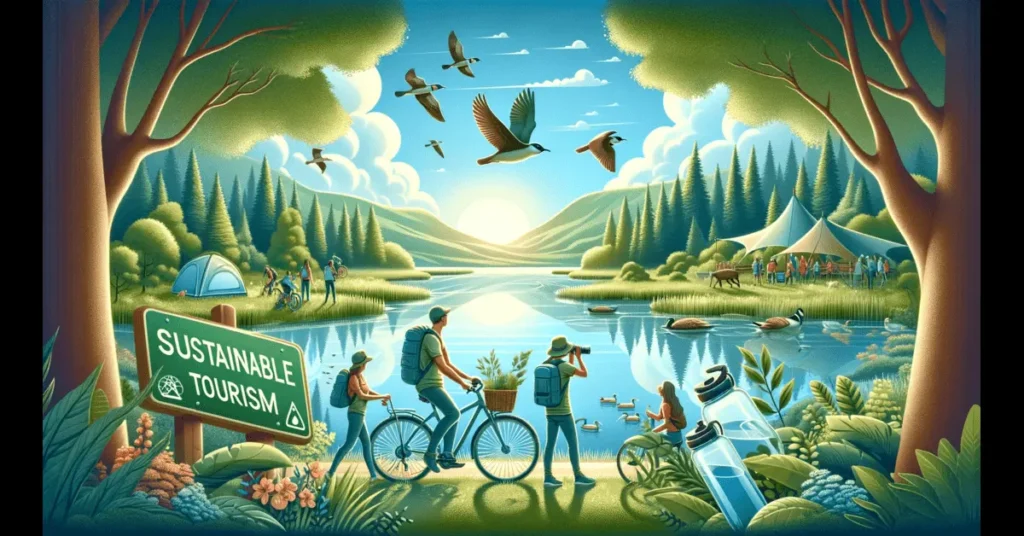Knowing Sustainable Tourism and Its Importance for Visitors and Locations
As visitation numbers surge globally, some locales face destabilization from over-tourism. However, sustainable tourism offers an increasingly more important opportunity approach with benefits for both communities and the environment.
here are the important thing points about what sustainable tourism means:
- Sustainable tourism refers to journeying locations in a manner that minimizes bad influences at the surroundings, nearby way of life, and communities.
- The purpose is for tourism to be controlled in a manner that it complements host communities socially and economically while retaining cultural traditions and herbal belongings for the destiny.
- It focuses on meeting the wishes of both travelers and locations – permitting locals and future site visitors to revel in the advantages of tourism over the long run.
- Essential factors include transportation choices with low emissions, eco-friendly accommodations
Key aspects include promoting local cultural authenticity, socio-economic empowerment for residents through tourism revenue and jobs, and environmental protection. The main goal is enabling destinations and ecosystems to thrive while enjoying all they have to offer generously and responsibly.
Why Sustainable Practices Matter for Sustainable Tourism
In some iconic spots, over tourism’s consequences include congested main streets, rising living costs as housing becomes hotels, and degraded natural areas. Less noticeably but critically, economic benefits often fail to reach communities as most profits leave the region.
For travelers, unsustainable activities like cave tubing in the Philippines or swimming with captive dolphins diminish authentic cultural experiences and ethical wildlife welfare. Locals may feel like attractions for onlookers rather than stakeholders in their home’s future.
Sustainable options address these issues through measures ensuring environmental and societal well-being alongside economic growth. Practicing responsible travel helps preserve destinations for generations of visitors and residents to appreciate.
Factors Impacting a Destination’s Sustainability
Key elements comprise transportation to and within locations, accommodations, activities offered, renewable energy and materials usage, waste management, and community engagement.
Understating each factor’s role in balancing tourism yields guidelines for travelers and industry.
Certifications for Sustainable Tourism
Popular certification programs provide framework and validation for destinations, hotels, tour operators and other tourism businesses striving for sustainability.
Green Globe: International standard assessing sustainability across environmental, socio-economic and cultural responsibility criteria.
Earth Check: Global benchmarking, certification and advisory group for travel/tourism sustainability performance.
LEED: Rating system for green building design, construction and operations.
Earning recognized credentials reassures conscientious travelers their dollars support qualities like renewable energy use, fair employment and wildlife/habitat protection.
Tips for Engaging in Sustainable Tourism
When planning trips, research options minimizing environmental impact and prioritizing local economic/social benefits. Choose partners with trusted certifications.Research eco-friendly accommodation options that are locally-owned and use renewable energy and green building materials.
- Consider homestays or guesthouses over large hotels. Use low-carbon forms of transportation like trains, buses, cycling or electric vehicles where possible instead of renting cars.
- Walk more in town centers. Support community-based tourism like working with local guides and artisans to experience authentic culture and boost the economy.
- Minimize single-use plastics and waste by bringing a reusable water bottle and sans bag. Properly dispose of trash or compost food scraps.
- select excursions and sports that educate approximately sustainable practices, have interaction in conservation efforts, and appreciate cultural and religious sites sensitively.
- guide nearby agencies through dining at restaurants serving indigenous ingredients and shopping at markets featuring artisanal items.
- Be water and energy conscious in daily practices like restricting lengthy showers and turning off lights while now not in use.
- Educate yourself on etiquette for photographing people and reimbursing subjects for their time if images will be used publicly.
- Offset your carbon footprint through community-run organizations funding renewable initiatives where you travel.
- Stay curious, ask respectful questions, and appreciate different viewpoints to better understand local ways of life.
UK Sustainable Tourism Destinations
Lake District National Park (England) – Strong protections for landscapes and habitats. Sustainable transport options like boat tours and electric car rentals.
Scottish Highlands – Community-owned nature reserves and many eco-lodges/campsites promoting localized sourcing and renewable energy.
Wales – Green tourism grants protect cultural/natural heritage. Coastal paths encourage outdoor exploration while protecting environments.
Cornwall (England) – Geothermal district heating initiatives. Grants support eco-businesses and attractions showcase mining/fishing industry histories.
Isle of Wight (England) – Ambitious goal for electric transport network by 2030. Esteemed England Coast Path circles island encouraging eco-activity tours.
Yorkshire Dales (England) – Sustainable tourism association guides green practices. Farm stays supporting agricultural tradition.
Northern Ireland – Green businesses certification inspires eco-accommodations and tours. Giant’s Causeway promotes walkable sightseeing preserving volcanic formations.
East Anglia (England) – Renewable infrastructure anchors ecotourism around wetlands, beaches and historic settlements.
As in the US, the UK sees sustainable destinations increasingly valuing environmental protection, cultural enrichment and community livelihoods through mindful tourism development and visitor initiatives.

US Sustainable Tourism Destinations
Hawaii: Innovates renewable technologies like electric buses and tide pool microgrids empowering off-grid locales
Utah: “Mighty 5” national parks partnership conserves wilderness through impact-offsetting programs[9].
Costa Rica: Pioneered ecotourism through reforestation, sustainable agricultural training and community tourism cooperatives.
New Mexico: Indigenous Pueblos share cultural traditions authentically through visitor orientations and solar-powered facilities.
As global sustainability evolves, US destinations increasingly welcome mindful travelers helping preserve natural and cultural gems through responsible appreciation.
Conclusion –Sustainable Tourism
understanding sustainable tourism’s broader impacts inspires practices leaving treasured destinations and populations better off after visits through renewable initiatives and empowering local livelihoods. With diligence, travel uplifts environments and communities visited while enlightening journeys for generations.
sustainability-focused tourism brings widespread benefits by considering a destination’s long-term environmental protection and socioeconomic welfare alongside travelers’ enjoyment. As visitation to treasured sites grows globally, adopting practices that empower both local communities and ecosystems proves increasingly important.Certification programs provide frameworks helping tourism organizations integrate renewable practices and mitigate over tourism’s potential downsides. Conscientious travelers also play a key role by researching sustainable accommodations, activities and transportation to minimize negative impacts.
Simple choices like supporting ecotourism cooperatives, reducing plastic use and learning about indigenous cultures authentically can positively impact destinations long after a visit. As sustainable options expand, vacationers enjoy enriching experiences while uplifting destinations and residents through renewed appreciation of local heritage.
Looking ahead, the tourism industry’s focus on sustainability will only amplify its potential to enlighten journeys worldwide and preserve attractions for future generations. As understanding grows, traveling minds and dollars can uplift environments, economies and cultural traditions wherever they flow. With diligence, the balanced revitalization tourism enables endures far beyond any single excursion’s end.









